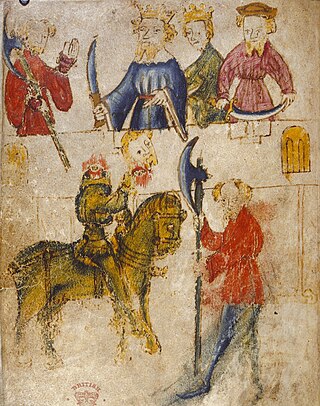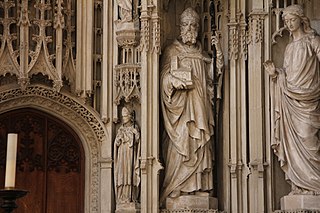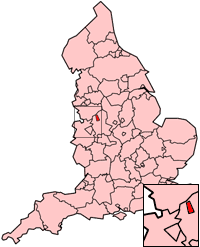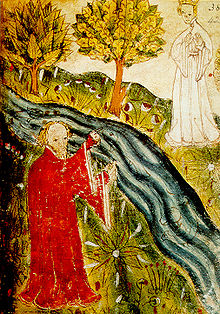
Sir Gawain and the Green Knight is a late 14th-century chivalric romance in Middle English alliterative verse. The author is unknown; the title was given centuries later. It is one of the best-known Arthurian stories, with its plot combining two types of folk motifs: the beheading game, and the exchange of winnings. Written in stanzas of alliterative verse, each of which ends in a rhyming bob and wheel; it draws on Welsh, Irish, and English stories, as well as the French chivalric tradition. It is an important example of a chivalric romance, which typically involves a hero who goes on a quest which tests his prowess. It remains popular in modern English renderings from J. R. R. Tolkien, Simon Armitage, and others, as well as through film and stage adaptations.
Patience is a Middle English alliterative poem written in the late 14th century. Its unknown author, designated the "Pearl Poet" or "Gawain-Poet", also appears, on the basis of dialect and stylistic evidence, to be the author of Sir Gawain and the Green Knight, Pearl, and Cleanness and may have composed St. Erkenwald. This is thought to be true because the techniques and vocabulary of regional dialect of the unknown author is that of Northwest Midlands, located between Shropshire and Lancashire.

In prosody, alliterative verse is a form of verse that uses alliteration as the principal device to indicate the underlying metrical structure, as opposed to other devices such as rhyme. The most commonly studied traditions of alliterative verse are those found in the oldest literature of the Germanic languages, where scholars use the term 'alliterative poetry' rather broadly to indicate a tradition which not only shares alliteration as its primary ornament but also certain metrical characteristics. The Old English epic Beowulf, as well as most other Old English poetry, the Old High German Muspilli, the Old Saxon Heliand, the Old Norse Poetic Edda, and many Middle English poems such as Piers Plowman, Sir Gawain and the Green Knight, Layamon's Brut and the Alliterative Morte Arthur all use alliterative verse.

The "Gawain Poet", or less commonly the "Pearl Poet", is the name given to the author of Sir Gawain and the Green Knight, an alliterative poem written in 14th-century Middle English. Its author appears also to have written the poems Pearl, Patience, and Cleanness; some scholars suggest the author may also have composed Saint Erkenwald. Save for the last, all these works are known from a single surviving manuscript, the British Library holding 'Cotton MS' Nero A.x. This body of work includes some of the most highly-regarded poetry written in Middle English.

Pearl is a late 14th-century Middle English poem that is considered one of the most important surviving Middle English works. With elements of medieval allegory and from the dream vision genre, the poem is written in a North-West Midlands variety of Middle English and is highly—though not consistently—alliterative; there is, among other stylistic features, a complex system of stanza-linking.
Cleanness is a Middle English alliterative poem written in the late 14th century. Its unknown author, designated the Pearl poet or Gawain poet, also appears, on the basis of dialect and stylistic evidence, to be the author of Sir Gawain and the Green Knight, Pearl, and Patience, and may have also composed St. Erkenwald.

The Green Knight is a heroic character of the Matter of Britain, originating in the 14th-century poem Sir Gawain and the Green Knight and the related medieval work The Greene Knight. His true name is revealed to be Bertilak de Hautdesert in Sir Gawain, while The Greene Knight names him "Bredbeddle". The Green Knight later features as one of Arthur's greatest champions in the fragmentary ballad "King Arthur and King Cornwall", again with the name "Bredbeddle".

St Erkenwald is a fourteenth-century alliterative poem in Middle English, perhaps composed in the late 1380s or early 1390s. It has sometimes been attributed, owing to the Cheshire/Shropshire/Staffordshire Dialect in which it is written, to the Pearl poet who probably wrote the poems Pearl, Patience, Cleanness, and Sir Gawain and the Green Knight.

Saint Earconwald or Erkenwald was a Saxon prince and Bishop of London between 675 and 693. He is the eponymous subject of one of the most important poems in the foundations of English literature. He was called Lundoniae maximum sanctus, 'the most holy figure of London', and Lux Londonie, "the light of London". Peter Ackroyd has said of him, "we may still name him as the patron saint of London, [his]... cult survived for over eight hundred years, before entering the temporary darkness of the last four centuries".
Huchoun, Huchown or Huchowne "of the Awle Ryale" is a poet conjectured to have been writing sometime in the 14th century. Some academics, following the Scottish antiquarian George Neilson (1858–1923), have identified him with a Scottish knight, Hugh of Eglinton, and advanced his authorship of several significant pieces of alliterative verse. Current opinion is that there is little evidence to support this.

Potteries is an English dialect of the West Midlands of England, almost exclusively in and around Stoke-on-Trent, Staffordshire.

The Cheshire dialect is a Northern English dialect spoken in the county of Cheshire in North West England. It has similarities with the dialects of the surrounding counties of Merseyside, Greater Manchester, Staffordshire, Shropshire, and Derbyshire.
Bernard O'Donoghue FRSL is a contemporary Irish poet and academic.
Bob and wheel is the term for a pairing of two metrical schemes. The wheel is a type of rhythm used in hymns or narrative songs sung in European churches or gatherings from the 12th to the 16th Centuries. A wheel occurs when at the end of each stanza, the song and the lyric return to some peculiar rhythm. In some instances the wheel is a return to something that resembles no definable poetic rhythm. A bob is a very short line, often two assertive syllables that announces the start of the wheel.

Lady Bertilak are names given by some modern critics to a character in the medieval poem Sir Gawain and the Green Knight, though the poem itself only ever calls her "the lady". She is ordered by her husband, Sir Bertilak de Hautdesert, alias the Green Knight, to test Sir Gawain's purity.
Ronald Alan Waldron is an English medievalist, considered a pre-eminent expert in the field of early English literature. He wrote many books and was a lecturer at the University of Aarhus in Denmark and King's College London. He made an especial focus on the poem Sir Gawain and the Green Knight.
The Alliterative Revival is a term adopted by literary historians to refer to the resurgence of poetry using the alliterative verse form in Middle English between c. 1350 and 1500. Alliterative verse was the traditional verse form of Old English poetry; the last known alliterative poem prior to the Revival was Layamon's Brut, which dates from around 1190.
Marie Edith Borroff was an American poet, translator, and the Sterling Professor of English emerita at Yale University.
Oxford, Bodleian Library, MS Fairfax 16, also known as the Fairfax Manuscript, is a fifteenth-century Middle English poetic anthology which contains one of the finest collections of Chaucerian verse of this period. Owned and commissioned by John Stanley of Hooton, Cheshire, Fairfax 16 was produced in Oxford or London in the mid-fifteenth century. Thomas Fairfax bequeathed it to the Bodleian Library in 1671.

The Pearl Manuscript, also known as the Gawain manuscript, is an illuminated manuscript produced somewhere in northern England in the late 14th century or the beginning of the 15th century. It is one of the best-known Middle English manuscripts, the only one containing alliterative verse solely, and the oldest surviving English manuscript to have full-page illustrations. It contains the only surviving copies of four of the masterpieces of medieval English literature: Sir Gawain and the Green Knight, Pearl, Cleanness, and Patience. It has been described as "one of the greatest manuscript treasures for medieval literature", and "the most famous of all romance manuscripts".











